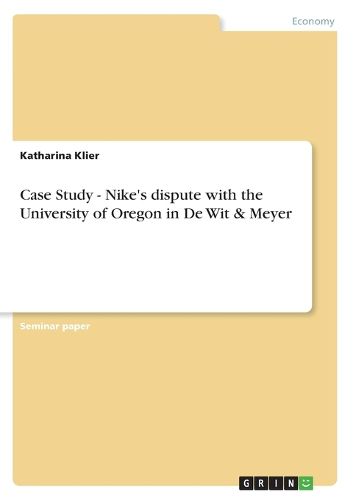Readings Newsletter
Become a Readings Member to make your shopping experience even easier.
Sign in or sign up for free!
You’re not far away from qualifying for FREE standard shipping within Australia
You’ve qualified for FREE standard shipping within Australia
The cart is loading…






Seminar paper from the year 2011 in the subject Business economics - Business Management, Corporate Governance, grade: 1,0, University of Sunderland, language: English, abstract: Executive Summary: This report analyses the actual strategic position of the sports company Nike and carries out the development of the global sport’s industry and its influences on Nike. In order to analyse the external and internal influences, this report will commence with Porter’s value chain model and his five forces framework to critically evaluate the reasons for Nike’s strategic decision to outsource its manufacturing factories to Asia. The reader will also achieve an understanding of the environment in which the company operates, which will be enlarged in the following part, by evaluating the advantages of international trade for Nike. The second part of this report will concentrate on two of Whittington’s schools of thought and concentrates on Nike’s systemic approach to its strategic position. Finally, Mintzberg s cultural and environmental schools of thought will be discussed and compared to illustrate Nike’s development between the years of 1996 and 2000.
$9.00 standard shipping within Australia
FREE standard shipping within Australia for orders over $100.00
Express & International shipping calculated at checkout
Seminar paper from the year 2011 in the subject Business economics - Business Management, Corporate Governance, grade: 1,0, University of Sunderland, language: English, abstract: Executive Summary: This report analyses the actual strategic position of the sports company Nike and carries out the development of the global sport’s industry and its influences on Nike. In order to analyse the external and internal influences, this report will commence with Porter’s value chain model and his five forces framework to critically evaluate the reasons for Nike’s strategic decision to outsource its manufacturing factories to Asia. The reader will also achieve an understanding of the environment in which the company operates, which will be enlarged in the following part, by evaluating the advantages of international trade for Nike. The second part of this report will concentrate on two of Whittington’s schools of thought and concentrates on Nike’s systemic approach to its strategic position. Finally, Mintzberg s cultural and environmental schools of thought will be discussed and compared to illustrate Nike’s development between the years of 1996 and 2000.